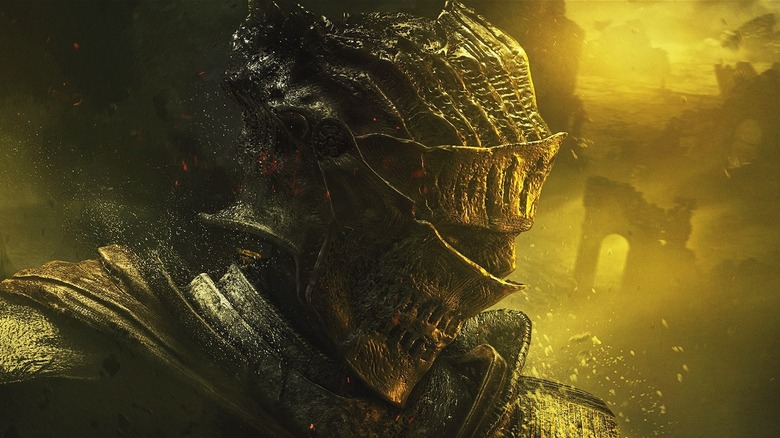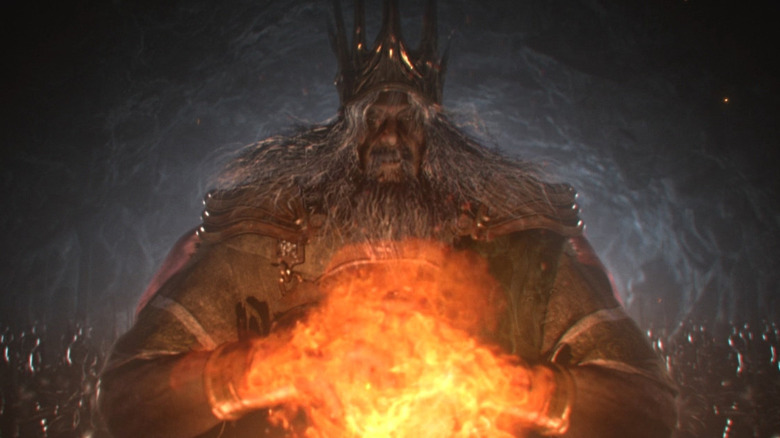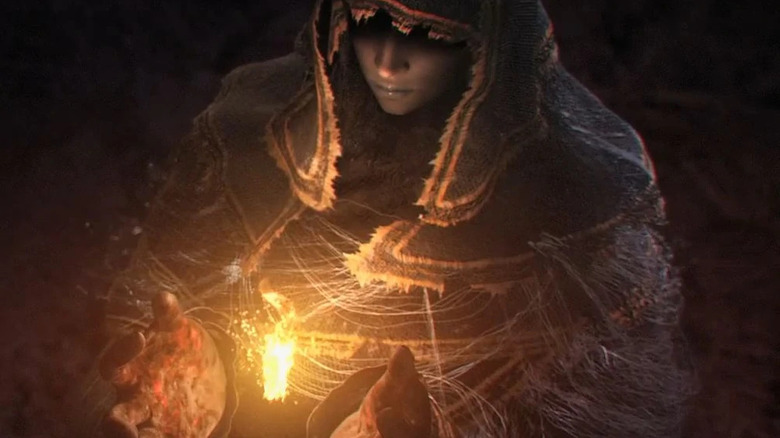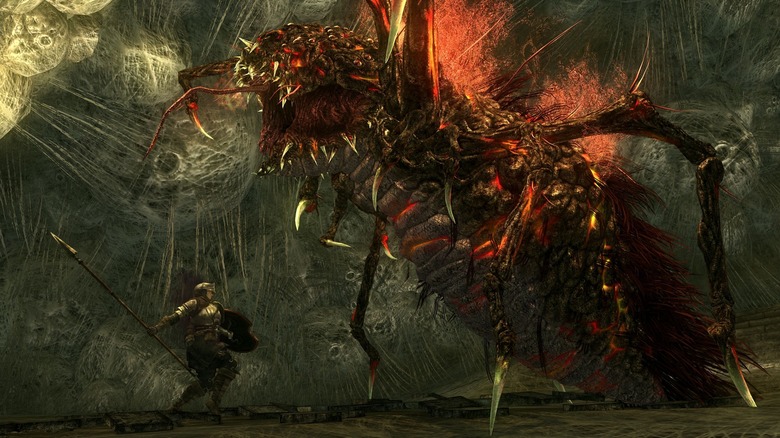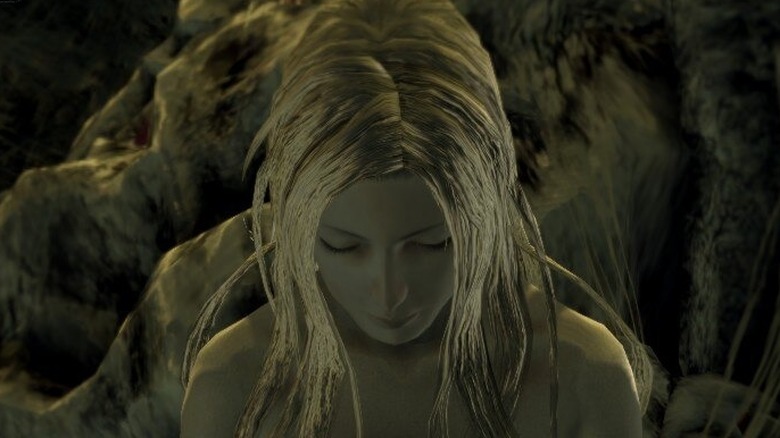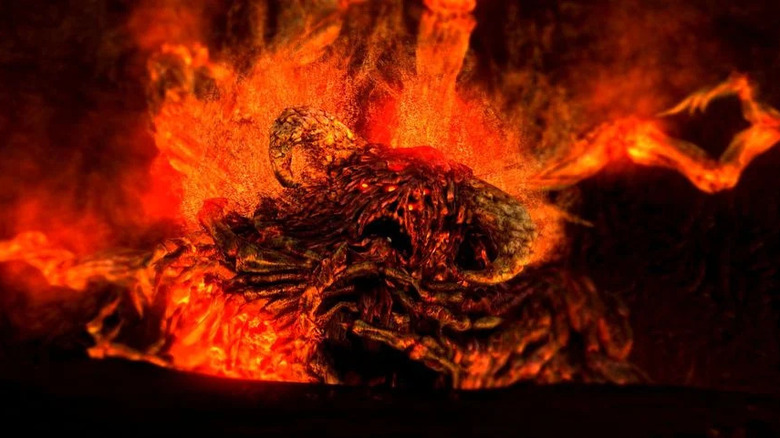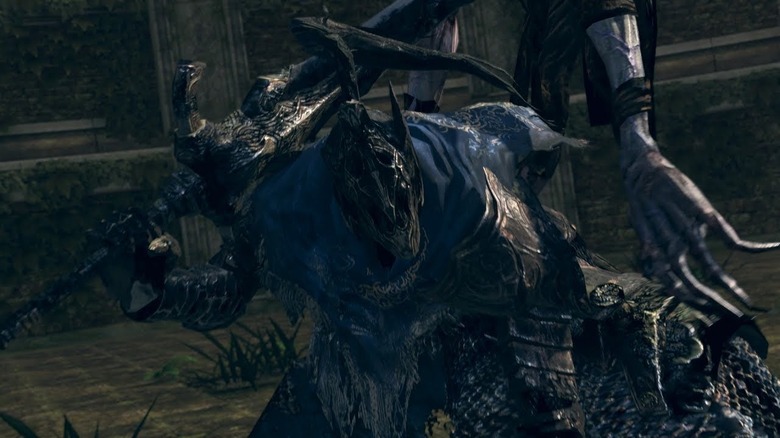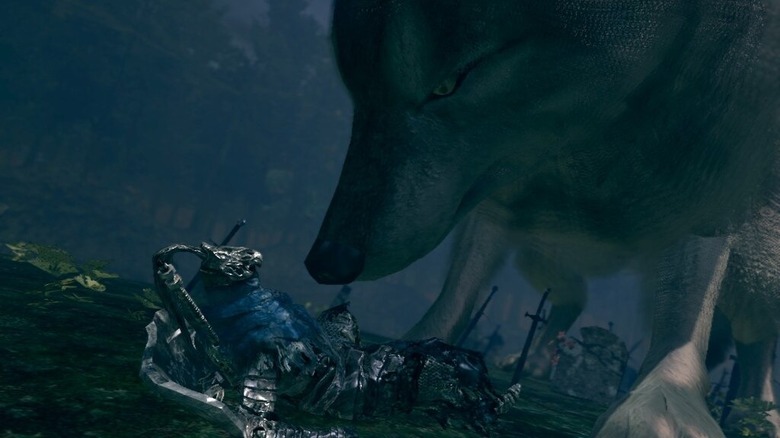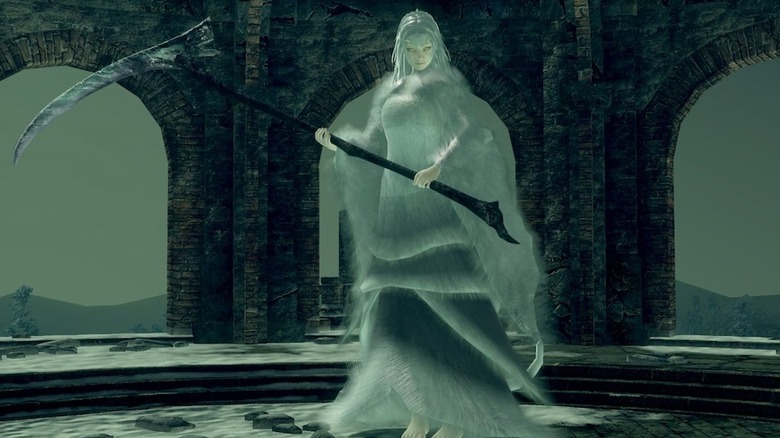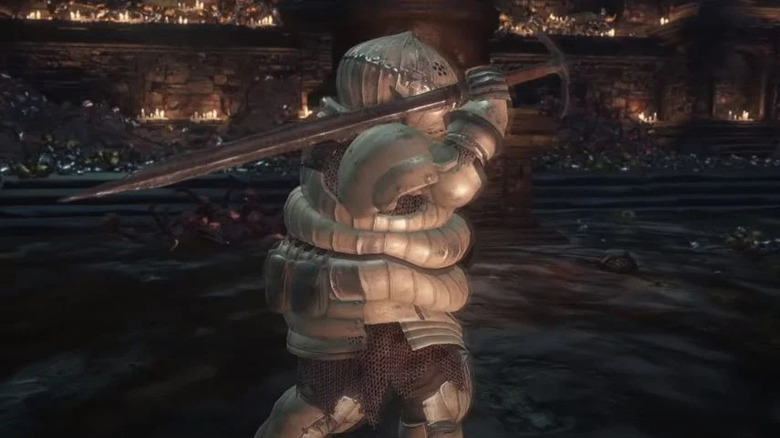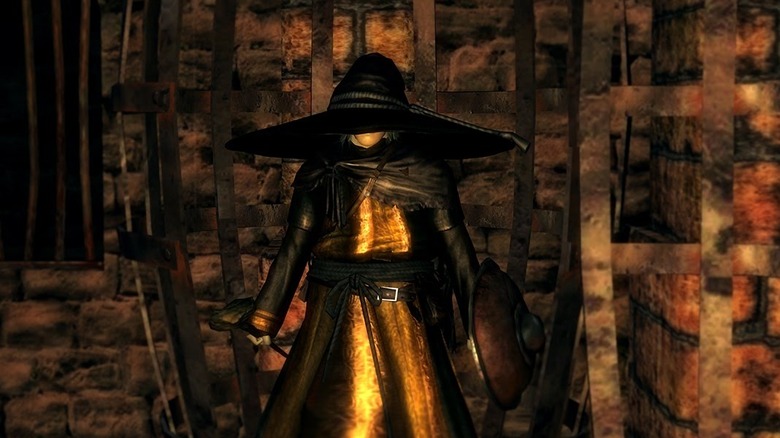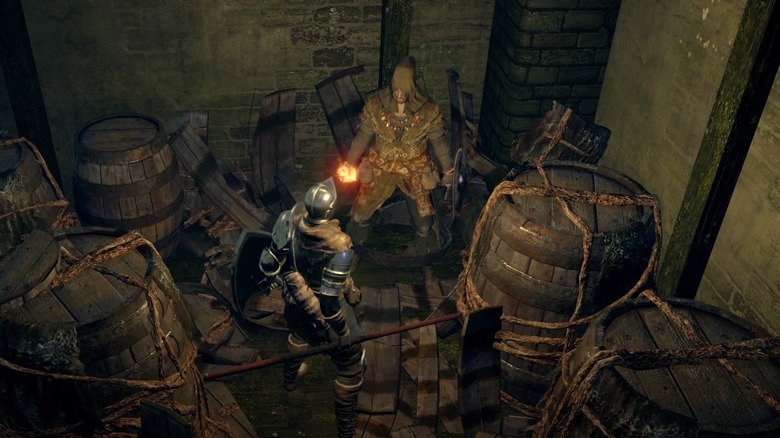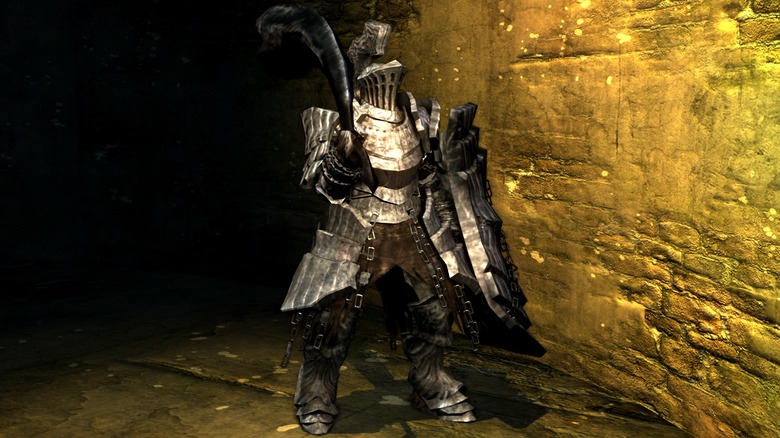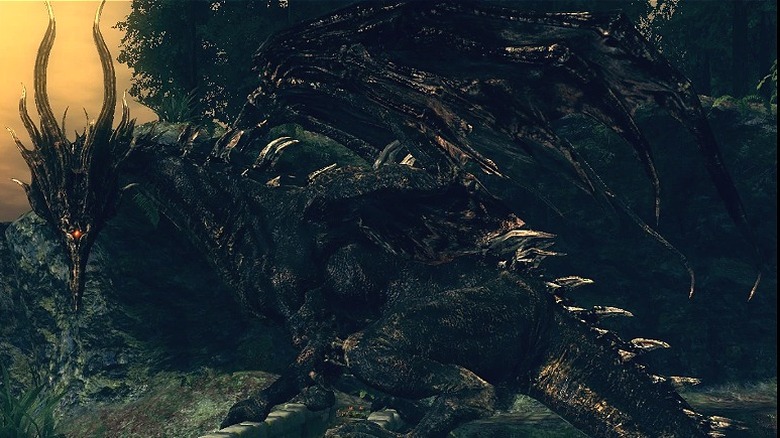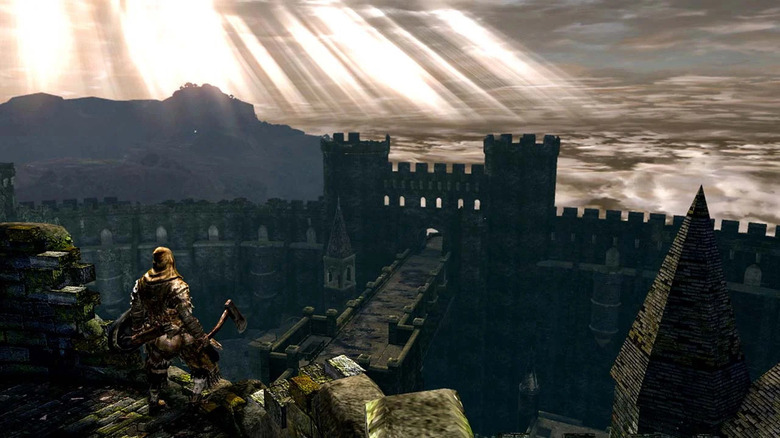Tragic Details You Missed In Dark Souls
More than a decade has passed since the first "Dark Souls" was released by FromSoftware and Bandai Namco. Deep retrospectives on the game's execution of its grand vision and impact on the larger video game landscape have landed "Dark Souls" multiple accolades, like the "Ultimate Game of All-Time" Golden Joystick Award. Dedicated fan communities have since sprouted up for all of FromSoftware's subsequent "Souls" games.
The "Soulslike" moniker is typically slapped on any challenging, unforgiving game mechanic that recalls "Dark Souls." And while the "Dark Souls" franchise is often noted by the novelty of its combat alone, but perhaps an even more challenging and rewarding experience is mastering the mythology of "Dark Souls."
Capturing glimpses of the lore, which is primarily told through bits and pieces of item descriptions and the half-mad ramblings of untrustworthy NPCs, is no small feat. Connecting these epistolary fragments into a coherent story requires active investigation by the player. Entire YouTube channels and have been dedicated to filling in the gaps of the series' story.
Players of "Dark Souls" can complete the game without any hint of what is going on — if they want to show up, merrily slay everything in their path, and complete "Dark Souls" without thinking twice about their wake of destruction, they can. However, as soon as one dips their toe into "Dark Souls" lore, there is no going back: Tragedy is everywhere. Regret, nostalgia, fading hope, and murky intentions abound, and stepping back from "Dark Souls" to view the fuller picture reveals tragedy on so many levels.
Gwyn is a shell of his former self
"Dark Souls" is known for its unforgiving challenges. And the boss fights in "Dark Souls" ramp up the difficulty ever further, inspiring awe and terrifying upon first encounter.
Gwyn, Lord of Cinder is the final boss of "Dark Souls." Gwyn is the main catalyst who ended the rule of ancient dragons and ushered in the Age of Fire (when the game takes place). He wielded lightning to smite the dragons and ruled over a societal golden era in their wake. So, facing him at the end of "Dark Souls," a game renowned for challenging boss fights, has to be an incredible experience, right?
Actually, walking through his misty gate at the Kiln of the First Flame doesn't trigger an action-movie-like cutscene, he says nothing to the player, and the fight starts with a somber piano song underscoring it. Gwyn stands only slightly taller than the player, a cindered husk of his former glory.
It turns out that Gwyn used all of his strength to keep the First Flame alive much longer than should be allowed. The Age of Fire that Gwyn had begun started fading long ago, and when the player defeats him, they're simply extinguishing a smoldering flame that had long since burnt out. Adding insult to injury, Gwyn is the only boss that has parry-able attacks. Some players may feel let down by his fight's lack of awe, but ending things on such a somber note may strike a deep chord with players more in tune with the "Dark Souls" mythos.
The Witch of Izalith created chaos on accident
The Age of Flame that was ushered in by Gwyn and his allies began with the discovery of Lord Souls in the First Flame. Gwyn, Nito, and the Witch of Izalith all obtained Lord Souls, which imbued them with the power to challenge the ruling order of the Everlasting Dragons.
The Witch of Izalith is only seen once in "Dark Souls," in the very beginning cutscene. She is tall, blue-lipped and pale-skinned, shown with burned hands upon grasping her Lord Soul.
When the First Flame that birthed the Lord Souls began to dwindle in its strength, the Witch of Izalith attempted to use her Lord Soul to create a new one to prolong the Age of Fire. This was a mistake, as the imitation flame became uncontrollable and turned itself into the Bed of Chaos, a boss that the player later fights for the Witch of Izalith's Lord Soul. This Bed of Chaos birthed chaos itself into the world through demons. The Witch of Izalith's children all attempted to control this emerging chaos, only to be turned into fiery demons themselves.
Like many other bosses in "Dark Souls", the offspring of the Witch of Izalith are not overtly evil beings whom the players bring to justice. Instead, as discussed in a video by VaatiVidya, the Witch's desire for preservation in the face of the unknown is a relatable, mortal feeling. In "Dark Souls", the road to hell is paved with good intentions.
Chaos Witch Quelaag is only trying to save her sister
During the Witch of Izalith's attempted rekindling of the First Flame and subsequent birthing of the Bed of Chaos, two of her daughters Quelaag and The Fair Lady, suffered horrible fates. Their mental faculties did not become distorted, but both of their physical forms morphed into mutant tarantulas with princess-like heads.
After their mutations and the fall of Izalith, the two sisters made their way to Blighttown to escape the deranged happenings in Izalith. There, they amassed disease-ridden followers. Attempting to cure these Blighttown inhabitants of their blight by absorbing it into herself, The Fair Lady became poisoned and lost her eyesight. From that point on, Quelaag's mission in life became to fix her sister's ailment, and to a larger degree, solve the blight that plagued her sister and Blighttown. Her methods to solve this problem involved luring humans and undead into Blighttown, only to kill them to acquire the essence of their Humanity, which she would stockpile to use as a curative agent against her sister's ailment.
The player in "Dark Souls" ventures into Blighttown, taking down every enemy in their path to meet Quelaag in a boss fight. Without considering anyone else's perspective, slaying a tarantula-princess mutant in the depths of Blighttown seems like the correct thing to do. But, when one considers that the sisters of chaos are basically refugees from the horrible experiment that consumed the rest of their family, then the morals of the situation become much more complicated.
The Fair Lady doesn't know the fate of her sister
Meanwhile, The Fair Lady is hidden within Blighttown by her sister Quelaag, who was determined to cure her blight. The player in "Dark Souls" encounters Quelaag in Blighttown and slays her and takes her Soul, opening up the path to The Fair Lady's secret hideout. Of course, The Fair Lady is blind and doesn't know of these happenings, so when the player shows up in her den, she believes that the player is Quelaag.
Masquerading around with the Soul of her now-dead sister, the player has a few choices about how to deal with the Fair Lady. They can offer her Humanity to cure her, as Quelaag had hoped to do. After giving her 80 Humanity, the Fair Lady says she can move her legs around and she stops complaining about her pain, suggesting Quelaag's plan may have worked.
Like everyone else in "Dark Souls," the player has the option to slay her, even though she poses no threat to the player. If the player chooses this dark route, she thinks that her sister Quelaag is the one to slay her, asking softly through her death rattle, "Sister... Why...?"
Ceaseless Discharge is preserving the memory of his sister
Another abomination child of the Witch of Izalith's failed kindling of the First Flame, Ceaseless Discharge was transformed from Izalith's youngest son into the first demon ever to roam Lordran. Fighting him is certainly a memorable experience, as he is one of the largest bosses in the player's path.
However, he doesn't actually stand in the way of the player. At least, he doesn't view the player as a threat that needs to be killed upon entry into his lair. Instead, the fight with Ceaseless Discharge only begins after the player loots the nearby body of a woman. That body that the player loots is actually one of his fallen sisters. He honors her by standing guard over her remains, a memory that his horrible and corrupted body hasn't let go of, even after eons of torment.
And what does Ceaseless Discharge get for his unending loyalty to his family? He's rewarded by letting a jumpstart undead (the player) into his lair without alarm, only for them to desecrate the one thing he cares about most. Enraged by this disrespect, Ceaseless Discharge attacks the players and is eventually slain, joining his long-lost family in the afterlife of "Dark Souls". This tragedy hits so hard for some players that they find slaying Ceaseless Discharge morally challenging.
The Memory of Artorias the Abysswalker
Artorias the Abysswalker was one of the Four Knights that fought alongside Gwyn during the birth of the Age of Flame. He was the only member of this elite group who was capable of venturing into the Abyss.
The Abyss in "Dark Souls" is a destructive void rooted in the worst aspects of humanity. Its ruler, Manus, was a human who was corrupted and buried deep beneath the human city of Oolacile. When Gwyn's Age of Fire began to dwindle, the Abyss started rampaging through all human cities.
Artorias and his wolf companion, Sif, set out to stop the spread of the Abyss. He failed in his attempt, eventually relenting to the unstoppable tide that the Abyss presented. In his last act of heroism, he saved Sif with his shield.
Shortly thereafter, the Abyss stopped spreading. Artorias was then remembered as the one who sacrificed himself by venturing into the Abyss and halting its advance. However, as pointed out by VaatiVidya, only the player knows that it wasn't Artorias, but the game's protagonist themself, who quelled the Abyss.
In the "Artorias of the Abyss" DLC, players travel back in time to Oolacile to put Artorias' spirit to rest and stop Manus. Only the ancient cat Alvina, who lives in the game's present, knows this shrouded history to be "none but a fabrication." While she still respects Artorias for his attempt and for saving his companion Sif, Alvina knows that the knight's honor was only truly restored after his corrupted body was finally put to rest by the player.
Sif recognizes the player from eons ago
Sif, the greatsword-wielding wolf companion of Artorias, is one of the most iconic boss fights in "Dark Souls." This fight is required to progress further in the story, so players have no choice but to harm this loyal companion to progress in the story.
As mentioned previously, Sif ventured deep into the Abyss with Artorias, only to be by his master, who would shortly succumb to the Abyss' overwhelming power. However, in the "Dark Souls: Artorias of the Abyss" DLC, the player has the choice to aid Artorias' in saving Sif, giving Sif and the player a history dating back eons. Since that event, Sif has sat watch over Artorias' grave, guarding the Covenant of Artorias, the ring that allowed him to travel to the Abyss.
If the player helped save Sif back in time in Oolacile, then a tear-jerking cutscene plays before the Great Grey Wolf Sif boss fight that happens in Darkroot Garden. Sif pounces on the player, smelling them up close, before letting out a sorrowful howl at the moon. He knows the player's smell from all those centures ago, and recognizes them as his savior and Artorias' helper. Tragically, Sif then wields his greatsword, ready to fight the player because he is soul-bound to guard the Covenant of Artorias.
Even long-lost friends in "Dark Souls" don't get happy endings, and the player eventually slays Great Grey Wolf Sif, just as they did Artorias.
Crossbreed Priscilla doesn't want to fight
Though it was dethroned by Gwyn's Age of Fire, the order of Everlasting Dragons left behind few descendants. Seath the Scaleless, the crystalline betrayer of his kind, was the only dragon to ally with Gwyn and be rewarded with power during the Age of Fire. If he had any offspring, then they would likely be regarded with hostilities in the Age of Fire, so hiding them would make sense.
Players come across Crossbreed Priscilla in Anor Londo, located within the Painted World of Ariamis. She is the only of her kind throughout "Dark Souls," with a draconic tail and princess-like body. Her milky white tones and draconic appendages very closely resemble Seath The Scaleless, suggesting that she may be the child of Seath.
Regardless of parental lineage, she is immobile and hidden within a largely inaccessible world. She is either locked away or hidden within the Painted World, but after speaking with her she tells the player she likes it there, that's it's peaceful and she could leave at any point. After speaking with her and learning that her faculties seem entirely intact, the player doesn't have to fight Priscilla to leave the Painted World. But, if they want her loot and Souls, then Priscilla is attackable, like every other NPC ally in "Dark Souls."
Sadly, she makes the player feel terrible for attacking her and betraying her trust, delivering heartbroken voice lines like, "Why could thou not let us be?"
Siegmeyer's Hollowing
The jolly, onion-shaped knight from Catarina is one of the few NPCs in Lordran that has any sense of humor. Encountering Siegmeyer after drudging through the rest of the moody characters in "Dark Souls" is a breath of fresh air. He declares to the player that he is in Lordran simply to pursue adventure and to find glory, which are defining qualities of knights from Catarina.
Purpose in "Dark Souls" is a core theme, with each NPC character, each boss, and even the player themselves being given specific purposes to fulfill. Losing one's path towards that greater purpose physically manifests through Hollowing, which represents the ultimate loss of drive, curiosity, purpose, and humanity.
Well, the player ends up stealing all of Siegmeyer's thunder along the way, chipping away at his purpose little by little until it is too much for him to bear. The player encounters Siegmeyer six times at different locations throughout their journey, and each meeting is centered around a big threat that Siegmeyer wants to defeat, only for the player to save him from that peril and gain the prestige of battle for themselves (per TheGamer).
He finally tries to sacrifice himself for the player in a battle against the Chaos Eaters, but if the player saves him from these enemies, it will be the last time the player sees him alive. After having his purpose stolen from him one time too many, Siegmeyer will turn hollow.
Big Hat Logan's Hollowing
Much like Siegmeyer's tragedy, Big Hat Logan is a friendly NPC who imparts wisdom to the player — only to eventually go down the darkest, most tragic of paths. Originally found locked away in Sen's Fortress, Big Hat Logan is a sorcerer who hopes to master the depths of magic uncovered by Seath the Scaleless' experiments.
Players use Big Hat Logan as their sorcery vendor for the majority of the game. However, once the player has learned all they can from Big Hat Logan, then the undead sorcerer loses his core purpose.
Talking to Logan after learning all of his sorceries will result in him no longer recognizing the player, clearly starting to lose his mind. After the defeat of Seath the Scaleless, the progenitor of sorcery magic, Big Hat Logan will turn fully Hollow and attack the player the next time he sees them in Seath the Scaleless' lair. After slaying Logan, the player will be able to wear his wizard-like armor, the only memory left of another friend lost to the Hollowing that comes with a loss of purpose.
Laurentius' Hollowing
Laurentius of the Great Swamp is an NPC who requires rescue from the sewer system known as The Depths. Players encounter him after slaying the Butcher mini-bosses on the other side of the Capra Demon boss fight. He is locked away in the corner of a small room. After freeing and talking to him, he will reside at Firelink Shrine, the hub where many NPC allies will eventually relocate throughout the main story of "Dark Souls."
There, Laurentius will act as a teacher of Pyromantic magic, and will grant the player a Pyromancy Flame if they don't already have one. However, once the player outshines Laurentius at his own game, all will start to go downhill for him. After the player meets with the Fair Lady, or else obtains access to Chaos Pyromancies through other means, the player will have the option of showing Larentius these advanced techniques the next time they speak with him.
Doing so will mark the last time the player sees Laurentius at Firelink Shrine, because he sets off on a quest to learn the same techniques as the player in Blighttown. Subsequently, the next time the player ventures into Blighttown, Laurentius can be found there — now turned fully Hollow. He mindlessly attacks the player, forcing them to slay another one-time friend who lost their purpose after the player one-upped them at their own calling. Helping someone in "Dark Souls" is often reframed as an intrusion on someone else's purpose, often with tragic consequences.
Havel and Gwyn betrayed each other
Players of "Dark Souls" are likely well-acquainted with Havel the Rock, as he is one of the first mini-bosses they face in the Undead Burg. Fighting Havel is not easy, as the powerful strikes from his colossal dragon's tooth weapon will often kill a player in one shot.
And if you're familiar with the lore of "Dark Souls," you can tell that fighting Havel the Rock back in his glory days was equally as challenging. He has a dragon's tooth as a weapon for a good reason: He was one of Gwyn's closest allies in the war against the Everlasting Dragons. Havel fought beside Gwyn because they shared such deep rooted anti-dragon and anti-magic sentiments. So, when Gwyn allied himself with Seath the Scaleless, it must have come across to Havel as a grand betrayal of their original purpose.
Havel is found at the bottom of the Undead Burg, long-since hollowed and turned into one of the undead. The Watchtower Basement Key that grants players access to this mini-boss has an item description that reads, "There are rumors of a hero turned Hollow who was locked away by a dear friend." While not explicitly named here, a fan theory suggests that Havel was locked away by his dear friend Gwyn after Havel turned hollow.
Kalameet is the last of the ancient Everlasting Dragons
Seath the Scaleless is the Everlasting Dragon that gets most of the spotlight in "Dark Souls'" lore, since he is the one to catalyze the fall of the dragons and the beginning of the Age of Fire. However, he is not the only ancient dragon to survive Gwyns's onslaught.
Black Dragon Kalameet is the other ancient dragon that still roams Lordran. Until the player makes a deal with Hawkeye Gough, the blind archer of dragonslaying fame, Kalameet soars above Anor Londo and will kill the player instantly from above if they roam into his lair. Hawkeye Gough can wound him from afar, allowing the player to have a fair fight with him while he is partially grounded.
Cutting off dragon tails in "Dark Souls" will net special weapons for players, and Kalameet is no different. The Obsidian Greatsword, which is obtained after cutting off Kalameet's tail, also offers players a bit of tragic lore that confirms the end of an ancient lineage.
Its item description reads, "This greataxe, one of the rare dragon weapons, is formed by the tail of the one-eyed black dragon Kalameet, the last of the ancient dragons." While the text referring to the greatsword as a "greataxe" is likely a localization mistake, the part about the last of the ancient dragons should stick with the player, as their monumental action finally ends the existence of the dragons that ruled the world for eons before the Age of Fire.
Corpses in Dark Souls are the Loot Pool
"Dark Souls" is renowned for innovating many aspects of gameplay mechanics, but it likewise is legendary for its seamless worldbuilding. Many games struggle with incorporating all aspects of gameplay into its narrative — a concept known as ludonarrative dissonance — but "Dark Souls" excels at this tricky endeavor.
Dying in "Dark Souls" is expected, both in terms of gameplay and narrative. The repetition of dying, hollowing, and reaching for humanity is perfectly explained by the game's lore, granting its practical gameplay mechanics a deep-rooted narrative purpose.
As part of this synergy between narrative and gameplay, "Dark Souls" makes most of its loot pool only accessible through the corpses on the ground. Slaying anything will grant the player a certain amount of Souls, and slaying more powerful monsters will grant a greater number. Strewn throughout the wreckage of each playable area are itemized souls of differing calibers on long-dead corpses.
The range of consumable souls from these corpses start at Soul of a Lost Undead (worth 200 souls) and end with Soul of a Great Hero (worth 20,000 souls). These Souls help the player gain strength from the failed attempts of the non-chosen undead, many of whom attempted to end the Age of Fire before the protagonist's quest began. "Dark Souls" doesn't let the player forget that the sacrifices of the past help the chosen undead, as seen in the protagonist's constant consumption of their fallen brethren.

